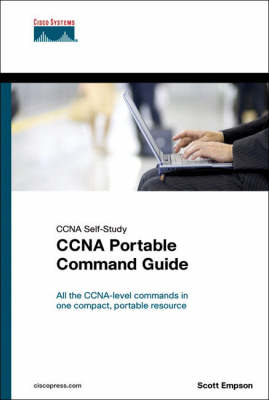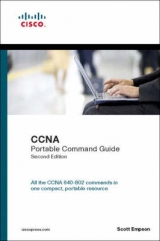
CCNA Portable Command Guide
Cisco Press (Verlag)
978-1-58720-158-5 (ISBN)
- Titel erscheint in neuer Auflage
- Artikel merken
All the CCNA-level commands in one compact, portable resource
Access all CCNA commands–use as a quick, offline resource for research and solutions
Logical “how-to” topic groupings provide one-stop research
Great for review before CCNA certification exams
Compact size makes it easy to carry with you, wherever you go
“Create your own journal” section with blank, lined pages allows you to personalize the book for your needs
Preparing for the CCNA® exam? Working as a network administrator? Here are all the CCNA-level commands you need in one condensed, portable resource. The CCNA Portable Command Guide is filled with valuable, easy-to-access information, and portable enough for use whether you’re in the server room or the equipment closet.
This book will help you memorize commands and concepts as you work to pass the CCNA exam (INTRO 640-821, ICND 640-811, or CCNA 640-801). The guide summarizes all CCNA certification-level Cisco IOS® Software commands, keywords, command arguments, and associated prompts, providing you with tips and examples of how to apply the commands to real-world scenarios. Configuration examples throughout the book provide you with a better understanding of how these commands are used in simple network designs.
Nine CCNA topic areas are covered, including:
TCP/IP
An Introduction to Cisco Devices
Configuring a Router
Routing
Switches
Network Administration and Troubleshooting
Managing IP Services
WANs
Network Security
This book is part of the Cisco Press® Certification Self-Study Product Family, which offers readers a self-paced study routine for Cisco certification exams. Titles in the Cisco Press Certification Self-Study Product Family are part of a recommended learning program from Cisco Systems® that includes simulation and hands-on training from authorized Cisco Learning Partners and self-study products from Cisco Press.
Scott Empson is an instructor in the telecommunications department at the Northern Alberta Institute of Technology in Edmonton, Alberta, Canada, teaching Cisco® routing, switching, and network design courses in certificate, diploma, and applied degree programs at the post-secondary level. He is also the program coordinator of the Cisco Networking Academy® Program at NAIT, a Regional Academy covering Central and Northern Alberta. He has earned three undergraduate degrees and currently holds several industry certifications, including CCNP®, CCDA®, CCAI, and Network+.
Introduction
Part I TCP/IP
Chapter 1 How to Subnet
Class A–E Addresses
Converting Between Decimal Numbers and Binary
Subnetting a Class C Network Using Binary
Subnetting a Class B Network Using Binary
Binary ANDing
Question 1
Answer
Question 2
Answer
So Why AND?
Shortcuts in Binary ANDing
The Enhanced Bob Maneuver for Subnetting
Chapter 2 VLSM
IP Subnet Zero
VLSM Example
Step 1 Determine How Many H Bits Will Be Needed to
Satisfy the Largest Network
Step 2 Pick a Subnet for the Largest Network to Use
Step 3 Pick the Next Largest Network to Work With
Step 4 Pick the Third Largest Network to Work With
Step 5 Determine Network Numbers for Serial Links
Chapter 3 Route Summarization
Example for Understanding Route Summarization
Step 1: Summarize Winnipeg’s Routes
Step 2: Summarize Calgary’s Routes
Step 3: Summarize Edmonton’s Routes
Step 4: Summarize Vancouver’s Routes
Route Summarization and Route Flapping
Requirements for Route Summarization
Part II Introduction to Cisco Devices
Chapter 4 Cables and Connections
Connecting a Rollover Cable to Your Router or Switch
Terminal Settings
LAN Connections
Serial Cable Types
Which Cable to Use?
568A Versus 568B Cables
Chapter 5 The Command-Line Interface
Shortcuts for Entering Commands
Using the † Key to Complete Commands
Using the Question Mark for Help
enable Command 44 exit Command 44 disable Command 45 logout Command
Setup Mode
Keyboard Help
History Commands
show Commands
Part III Configuring a Router
Chapter 6 Configuring a Single Cisco Router
Router Modes
Global Configuration Mode
Configuring a Router Name
Configuring Passwords
Password Encryption
show Commands
Interface Names
Moving Between Interfaces
Configuring a Serial Interface
Configuring an Ethernet/Fast Ethernet Interface
Creating an MOTD Banner
Setting the Clock Time Zone
Assigning a Local Host Name to an IP Address
no ip domain-lookup Command
logging synchronous Command
exec-timeout Command
Saving Configurations
Erasing Configurations
Configuration Example: Basic Router Configuration
Part IV Routing
Chapter 7 Static Routing
Static Routing
The permanent Keyword (Optional)
Static Routes and Administrative Distance (Optional)
Default Routing
Verifying Static Routes
Configuration Example: Static Routes
Chapter 8 RIP
IP Classless
RIP Routing: Mandatory Commands
RIP Routing: Optional Commands
RIP Version 2
Troubleshooting RIP Issues
RIP Version 2: Mandatory Commands
RIP Version 2: Optional Commands
Configuration Example: RIP-2 Routing
Chapter 9 IGRP
IGRP Routing: Mandatory Commands
IGRP Routing: Optional Commands
Troubleshooting IGRP Issues
Chapter 10 EIGRP
Configuring EIGRP
EIGRP Auto Summarization
Verifying EIGRP
Troubleshooting EIGRP
Configuration Example: EIGRP
Chapter 11 Single-Area OSPF
OSPF Routing: Mandatory Commands
Wildcard Masks
Using Wildcard Masks with OSPF Areas
OSPF Routing: Optional Commands
Loopback Interfaces
OSPF DR/BDR Election
Modifying OSPF Cost Metrics
OSPF Authentication: Simple
OSPF Authentication Using MD5 Encryption
OSPF Timers
Propagating a Default Route
Verifying OSPF Configuration
Troubleshooting OSPF
Configuration Example: Single-Area OSPF
Part V Switches
Chapter 12 Configuring a Switch
Help Commands
Command Modes
Verifying Commands
Resetting Switch Configuration
Setting Host Names
Setting Passwords: 1900 Series Switches
Setting Passwords: 2900/2950 Series Switches
Setting IP Address and Default Gateway
Setting Interface Descriptions
Setting Duplex Settings: 1900 or 2900/2950 Series Switches
Setting Speed Settings: 2900/2950 Series Switches
Setting Web-Based Interface for Configuration: 1900 and 2900/
2950 Series Switches
Managing the MAC Address Table: 1900 and 2900/2950 Series
Switches
Configuring Static MAC Addresses
Port Security: 1900 Series Switches
Verifying Port Security
Configuration Example: 2900 Series Switch
Chapter 13 Spanning Tree Protocol and EtherChannel
Spanning Tree Protocol
Spanning-Tree Verification
Change Spanning-Tree Priority of a Switch
Changing the Cost of Spanning Tree on an Interface
Changing the State of Spanning Tree on an Interface
Spanning Tree Portfast BPDU Guard Command
EtherChannel
EtherChannel Configuration
Verification of EtherChannel
EtherChannel Tips
Chapter 14 VLANs
Displaying VLAN Information
Creating Static VLANs
Assigning Ports to VLANs
Assigning Ports Using the range Command (2950 Switch
Only)
Saving VLAN Configurations
Erasing VLAN Configurations
Troubleshooting VLANs
Configuration Example: 2900 Switch Configuration
Chapter 15 VTP and Inter-VLAN Communication
Configuring ISL Trunks
Configuring Dot1Q Trunks
Verifying Trunking
VTP Configuration
Confirming VTP Configuration
Inter-VLAN Communication: Router-on-a-Stick
Router-on-a-Stick Tips
Configuration Example: VTP and Inter-VLAN Routing
Part VI Network Administration and Troubleshooting
Chapter 16 Backing Up and Restoring Cisco IOS Software and
Configurations
Boot System Commands
Cisco IOS Software Prerelease 12.0 Commands Versus Cisco
IOS Software 12.x Commands
Backing Up Configurations
Restoring Configurations
Backing Up IOS to a TFTP Server
Restoring/Upgrading IOS from a TFTP Server
Restoring IOS from ROMmon Mode Using Xmodem
Restoring the IOS Using the ROMmon Environmental Variables and tftpdnld Command
Upgrading Catalyst 1900 Firmware with a TFTP Server
Copying IOS to TFTP Server
Firmware Upgrade of Catalyst 2950 Series Switches
Configuration Example: 2900 Series Switch
Chapter 17 Password Recovery Procedures and the
Configuration Register
The Configuration Register
The Configuration Register: A Visual Representation
The Configuration Register—What the Bits Mean
The Boot Field
Console Terminal Baud Rate Settings
Changing the Console Line Speed—CLI
Changing the Console Line Speed—ROM Monitor
Mode—1700/2600 Series
Password Recovery Procedures for Cisco Routers
Password Recovery for 1900 Series Switches
Password Recovery for 2900/2950 Series Switches
Chapter 18 CDP
Cisco Discovery Protocol
Chapter 19 Telnet
Telnet
Chapter 20 ping and traceroute
ICMP Redirect Messages
ping Command
ping
traceroute
Chapter 21 SNMP and Syslog
Configuring SNMP
Configuring Syslog
Chapter 22 Basic Troubleshooting
Viewing the Routing Table
Determining the Gateway of Last Resort
Determining the Last Routing Update
OSI Layer 3 Testing
OSI Layer 7 Testing
Interpreting the show interface Command
Clearing Interface Counters
Using CDP to Troubleshoot
traceroute Command
show controllers Command
debug Commands
Using Timestamps
OS IP Verification Commands
ip http server Command
netstat Command
Part VII Managing IP Services
Chapter 23 NAT
Configuring Dynamic NAT: One Private to One Public Address
Translation
Configuring PAT: Many Private to One Public Address
Translation
Configuring Static NAT: One Private to One Permanent Public
Address Translation
Verifying NAT and PAT Configuration
Troubleshooting NAT and PAT Configuration
Configuration Example: Port Address Translation
Chapter 24 DHCP
Configuring DHCP
Verifying and Troubleshooting DHCP Configuration
Configuring a DHCP Helper Address
Configuration Example: DHCP
Part VIII Wide-Area Networks
Chapter 25 HDLC and PPP
Configuring HDLC Encapsulation on a Serial Line
Configuring PPP on a Serial Line (Mandatory Commands)
Configuring PPP on a Serial Line (Optional Commands): Compression
Configuring PPP on a Serial Line (Optional Commands): Link Quality
Configuring PPP on a Serial Line (Optional Commands): Multilink
Configuring PPP on a Serial Line (Optional Commands): Authentication
Verifying or Troubleshooting a Serial Link/PPP Encapsulation
Configuration Example: PPP
Chapter 26 ISDN and DDR
Configuring ISDN BRI: Setting the Switch Type
Configuring ISDN BRI: Setting SPIDs
Configuring ISDN PRI
Verifying ISDN Configuration
Troubleshooting ISDN
Configuring Legacy DDR
Configuring Dialer Profiles with DDR
Configuration Example: ISDN and DDR with No Dialer
Profiles
Chapter 27 Frame Relay
Configuring Frame Relay: Setting the Frame Relay
Encapsulation Type
Configuring Frame Relay: Setting the Frame Relay
Encapsulation LMI Type
Configuring Frame Relay: Setting the Frame Relay DLCI Number
Configuring a Frame Relay Map
Configuring a Description of the Interface (Optional)
Configuring Frame Relay Using Subinterfaces
Verifying Frame Relay
Troubleshooting Frame Relay
Configuration Example: Frame Relay
Part IX Network Security
Chapter 28 IP Access Control List Security
Access List Numbers
ACL Keywords
Creating Standard ACLs
Applying a Standard ACL to an Interface
Verifying ACLs
Removing an ACL
Creating Extended ACLs
The established Keyword
Creating Named ACLs
Using Sequence Numbers in Named ACLs
Removing Specific Lines in a Named ACL Using Sequence
Numbers
Sequence Number Tips
Including Comments About Entries in ACLs
Applying an Extended ACL to an Interface
Restricting Virtual Terminal Access
Configuration Example: Access Control Lists
Part X Appendixes
Appendix A Complete Configuration Example
Appendix B Binary/Hex/Decimal Conversion Chart
Appendix C Create Your Own Journal Here
1587201585TOC112105
| Erscheint lt. Verlag | 24.11.2005 |
|---|---|
| Verlagsort | Indianapolis |
| Sprache | englisch |
| Maße | 153 x 228 mm |
| Gewicht | 418 g |
| Themenwelt | Mathematik / Informatik ► Informatik ► Netzwerke |
| ISBN-10 | 1-58720-158-5 / 1587201585 |
| ISBN-13 | 978-1-58720-158-5 / 9781587201585 |
| Zustand | Neuware |
| Haben Sie eine Frage zum Produkt? |
aus dem Bereich



